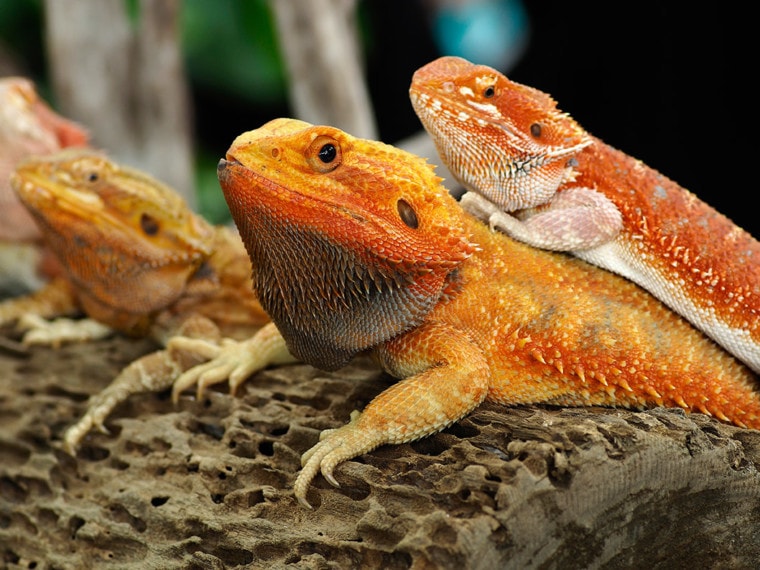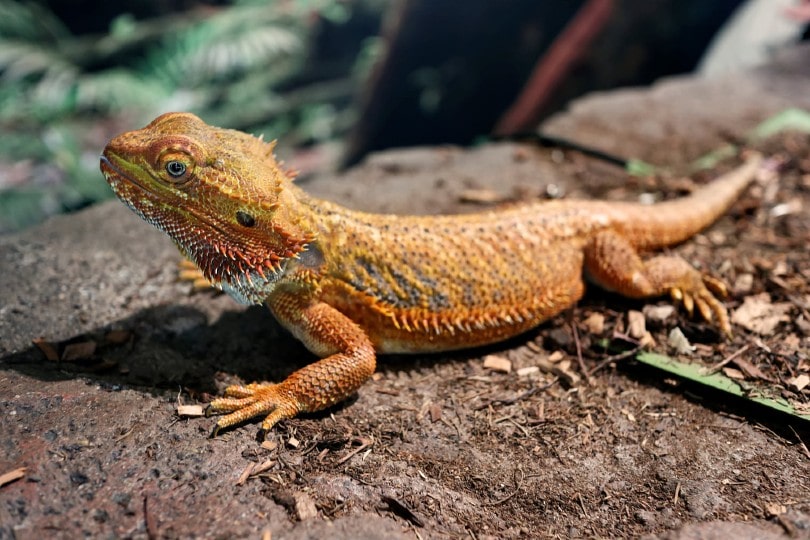
The red bearded dragon is a visually striking morph of the popular bearded dragon. As the name implies, it has a bright red color, although different variants do have different shades of red. As with all bearded dragons, it is considered a rewarding animal to own.
While the bearded dragon is widely considered a good pet, even for beginners, it does have some complex requirements. For example, feeder insects need to be gut loaded or dusted before being fed.
But they usually accept being handled, and are fascinating reptiles to watch. Read on to see what you need if you are considering taking on this species of lizard.
Quick Facts About Red Bearded Dragons
| Species Name: | Pogona vitticeps |
| Common Name: | Red Bearded Dragon |
| Care Level: | Moderate |
| Lifespan: | 10 years |
| Adult Size: | 16–24 inches |
| Diet: | Insects and vegetables |
| Minimum Tank Size: | 55 gallons |
| Temperature & Humidity: | 80°–105°F, 30–40% humidity |
Do Red Bearded Dragons Make Good Pets?
Bearded dragons are often described as being the best lizard or reptile pet for beginners. This is because they tolerate and even enjoy being handled by their owners. However, despite this, the bearded dragon may be considered to have a moderate to high care requirement because of some demanding habitat and special dietary needs. As long as you have the space for a large tank, the time to deal with proper feeding, and the concentration to reach and maintain humidity and temperature levels, the red bearded dragon can be considered a good pet.

Appearance
The bearded dragon, as a species, is quite prehistoric in appearance. They have scales, spines, and a spiky collar that they can inflate when stressed or when they are trying to attract a mate.
Beardies can grow to 24 inches, in length, and weigh approximately 1 pound. Their tail accounts for approximately half of their body length, and their exact coloring can vary according to the morph.
The red bearded dragon is one morph that is easy to spot. These do not occur in the wild and have been bred in captivity. The exact shade of red depends on the precise morph, but fully red and ruby red morphs attract high price tags.
How to Take Care of Red Bearded Dragons
Below are guidelines on the minimum tank and setup requirements to ensure your red bearded dragon is healthy.
Habitat, Tank Conditions & Setup
Tank
An adult bearded dragon requires a tank with at least a 55-gallon capacity and will benefit from having a larger tank with more space. Beardies do spend some time in trees when in the wild, so replicating this will give them a more fulfilling and enjoyable habitat. Logs, branches, and rocks provide some elevation. A half-log can also double up as a hide, which is an important part of a beardie’s tank décor.
Spot clean the tank every day to remove dead insects and to get rid of waste. If you do a good job of spot cleaning, you should only need to give the tank a full clean every month. A full clean means removing everything, disinfecting, and replacing the substrate with fresh.
Lighting
Beardies need regular exposure to UVB light. Provide special fluorescent lighting that offers the right UV spectrum, and ensure that your beardie can get within 12 inches of the bulb. A 12-hour day/night cycle replicates your beardie’s natural habitat.

Heating (Temperature & Humidity)
Provide a temperature gradient across the tank, from 80ºF at the cool end to a basking temperature as high as 105ºF at the other end. The temperature can drop to 70ºF at nighttime. Heat can be provided using ceramic heaters, mercury bulbs, and incandescent lights, and you should use thermometers to ensure that the temperature is always at an optimal level.
A humidity level between 30% and 40% should be maintained. Raising humidity is quite easy, but if you live in a humid area and need to drop the level, this can prove challenging. A hydrometer enables you to accurately monitor the humidity.
Substrate
Choosing the right substrate means finding something that replicates the arid environment they live in in the wild, but that will not cause damage if ingested with insects and other foods. Washed play sand allows burrowing but you should avoid silica sand. Other options include paper towels and reptile carpet. Sand should be avoided altogether when creating a habitat for juveniles.
| Tank Recommendations | |
| Tank Type: | 55-gallon glass vivarium |
| Lighting: | UVB fluorescent light |
| Heating: | Ceramic heater, mercury bulb, basking lamp |
| Best Substrate: | Washed play sand (adults), reptile carpets (juveniles) |
Feeding Your Red Bearded Dragon
Consisting of a combination of insects, vegetables, and fruit, a bearded dragon’s diet can seem somewhat complicated. Especially, when you incorporate the need to gut load and dust feeders. However, once you’re in the habit of proper feeding, it is not too difficult to maintain.
Young beardies grow quickly and need a diet to sustain this growth. Feed 75% insects and 25% plants. Young hatchlings are fed insects every quarter of an hour, and by 2 months of age, they will still need feeding protein three times a day.
Adults, which are beardies aged 18 months or older, should be fed once a day and be given 25% insects and 75% plants. Alternate and change the types of insects and plants you feed to keep your beardie interested in its food.
Insects should be gut-loaded at least a day before being fed to your beardies. This means feeding the insects nutrient-dense vegetables, thereby increasing the nutrients that your reptile digests in its meal.

| Diet Summary | |
| Fruits: | 10% of diet (juvenile)
25% of diet (adult) |
| Vegetables: | 15% of diet (juvenile)
50% of diet (adult) |
| Insects: | 75% of diet (juvenile)
25% of diet (adult) |
| Meat: | 0% of diet |
| Supplements Required: | Calcium/Vitamin D3 |
Keeping Your Red Bearded Dragon Healthy
As with most reptiles, the key to ensuring that your red bearded dragon remains happy and healthy is to maintain optimal habitat conditions. Use a thermometer and hydrometer to monitor temperature and humidity and adjust accordingly. Similarly, ensure that you provide a nutritionally appropriate diet.
Common Health Issues
Common health problems for the bearded dragon include:
Lifespan
The bearded dragon is expected to live between 6 and 10 years in captivity. A healthy lifestyle and a clean tank can only lengthen the time spent with your beardie.
Breeding
The female will usually lay eggs approximately 4 to 6 weeks after successful breeding. Once the pair have bred, you should separate the male and female because the male can be very aggressive. Offer a lay box, which is essentially a plastic box lined with soil. The eggs will need removing and incubating because beardies are not particularly maternal so may well ignore the eggs as soon as they are laid.

Are Red Bearded Dragons Friendly? Our Handling Advice
Bearded dragons rarely bite, and when they do it is usually with good reason. For the most part, this little reptile not only puts up with handling but seems to quite enjoy being on human hands and arms. Wash hands before and after handling a beardie, start with just a few minutes a day, and increase the time up to 20 minutes a day, but remember that your beardie needs the warmth and the confines of its tank, so do not keep it out of the tank for too long a period.
Shedding: What to Expect
Young bearded dragons will shed every few weeks and, when they are adults, they will shed every few months. The species usually sheds in patches rather than undergoing a whole body shed.
How Much Do Red Bearded Dragons Cost?
Although bearded dragons are quite common and a typical morph can cost as little as $50, the red bearded dragon is a lot rarer and you can expect to pay between $200 and $300 for a decent red morph. The darker the red, the higher the price tag that is usually associated with the beardie.
- You may also like: 10 Best Bearded Dragon Breeders: Our Top Picks
Care Guide Summary
Final Thoughts
The red bearded dragon is one of the more unusual and therefore expensive bearded dragon morphs, but like all beardies, it likes to be handled and has a docile and easygoing nature that makes it a great choice as a pet.
In fact, the beardie is widely considered to be a great first-time lizard. You will have to feed daily, keep the tank clean and temperate, and monitor your beardie to ensure that it stays fit and healthy.
- Related read: What Is a Dunner Bearded Dragon?
Featured Image Credit: ukjent, Shutterstock











